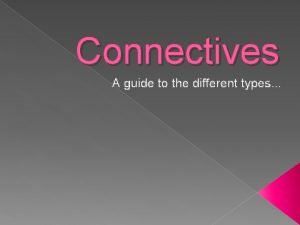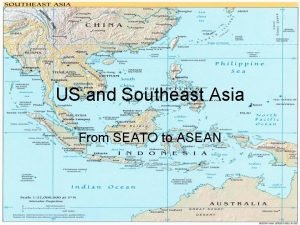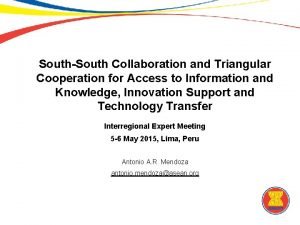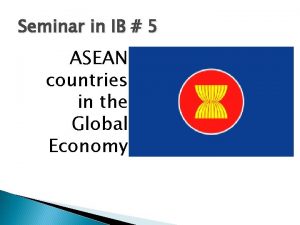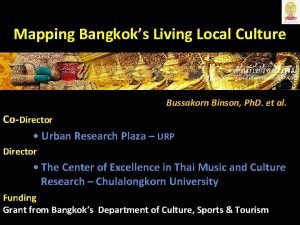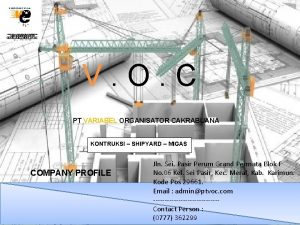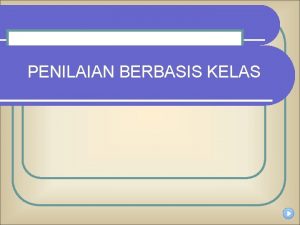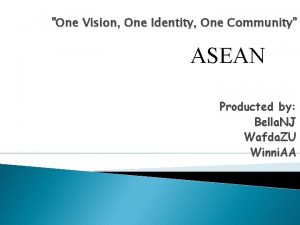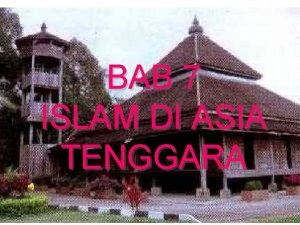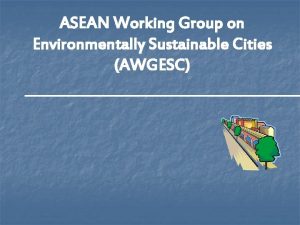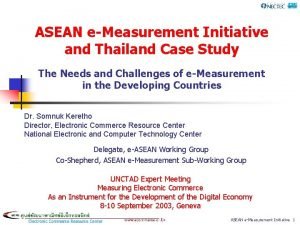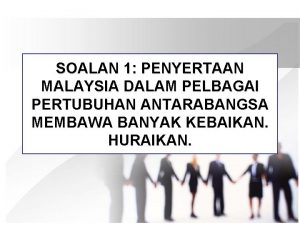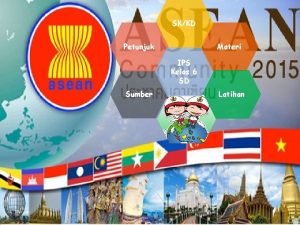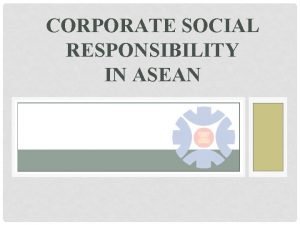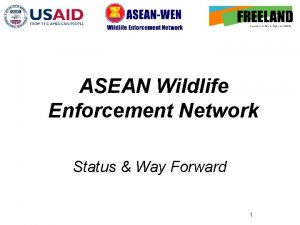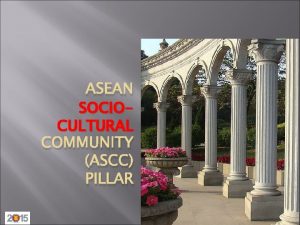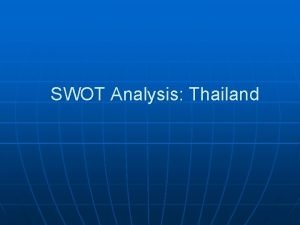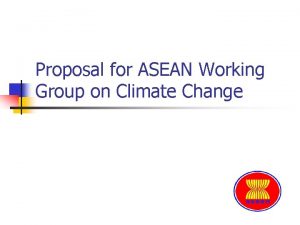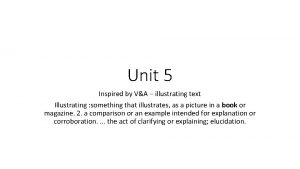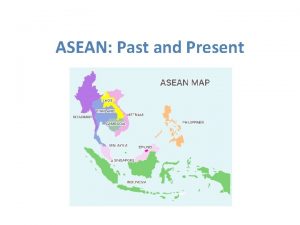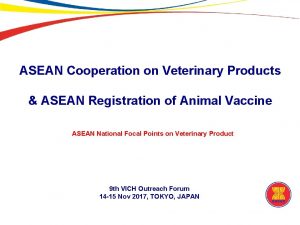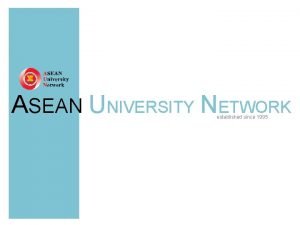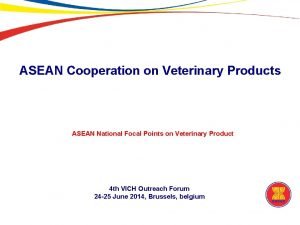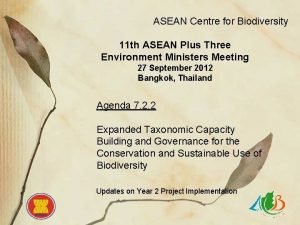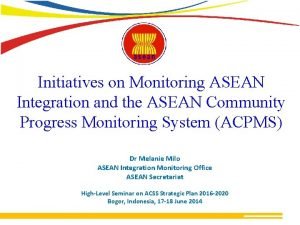ASEAN PPP SUMMIT Illustrating PPP with example in























- Slides: 23

ASEAN PPP SUMMIT Illustrating PPP with example in Waste Management

supporting major societal revolutions since 1858 THE TRADE REVOLUTION THE RESOURCE REVOLUTION THE URBAN COMFORT REVOLUTION THE HYGIENE & PUBLIC HEALTH REVOLUTION SUEZ canal inauguration 1858 -1869 After the war, big cities and suburbs increase their needs in water supply demand to provide a healthy water 24/7 for more people, to treat urban and industrial waste water, to collect but also store and incinerate increasing waste quantities. The industrial revolution leads to the development of cities in need of infrastructure for the sake of people’s’ hygiene and health: Water and sanitation networks are built over great distances, access to safe water is provided, and modern waste collection is invented. 1880 1945 1990 At the dawn of the 21 st century, a new chapter begins at the Rio Earth Summit. World leaders make the protection of the earth a priority. Cities and industries are seeking new solutions to face resource scarcity. Today

SUEZ, SUEZ employees operating on industrial and business customers turnover in 2016* over 90, 000 5 continents over 450, 000 € 15. 3 billion drinking water produced (worldwide)* drinking water distributed (worldwide)* waste water recycled (worldwide)* wastewater depolluted 5. 3 billion cubic meters 3, 162 million cubic meters activities at a glance A world leader in the smart and sustainable management of resources, we help cities and industries optimize water management, recycling and waste recovery. people benefiting from waste collection services* waste treated* (worldwide)* 882 million cubic meters hazardous waste treated* 92% recovered material from sorting centers* 34 million people 41 million tonnes 2. 9 million tonnes 10. 4 million tonnes consolidated figures including GE Water & Process Technologies as of December 31, 2016 *data as of 31/12/2016 without GE Water

PPP a tool to support Complexity of the Waste Management and Treatment Process

Why Public Authorities need PPPs in Waste Management Performance Drivers à Improve the Quality waste management of the Services à Limited capacity for efficient management and innovation which results in risks. Governance Drivers à Identify a responsible body with precise duties and charges à Transparency. Economical Drivers à Discrepancy between limited revenues and strong financing needs à Including a private partner increases the credibility of their loan demands à Difficulties in getting access to international finance. Environmental and Social Drivers à Infrastructure in need of capital improvements to meet environmental compliance issues à Difficulty in complying with regulatory standards. .

Private Sector Involvement Value creation for the client Contractor’s risk / revenue Privatization Range of Contracts to improve clients performance Concession contract* Full Utility Lease / affermage contract BOT / DBFO / PFI contracts Infrastructure Legend: Service contracts DBO contract Partial Utility => Operation & Maintenance (O&M)contract Infrastructure contracts Public Utility => Management contract Consulting engineering <= Support Technical assistance Consulting Public-Private Partnership (PPP) Asset ownership Increasing PP/operator’s time commitment and / or suitable context for PPP

The contracting model should match the main clients drives Objective drivers à à à What is the Objective of the Client? Technical and management skills? Operational Efficiency ? Increase private investment ? Construction optimization? Responsibility Drivers à What part of the responsibility is the client ready to delegate? Scope of work Drivers à à Which duration does the client want to be engaged? Which level of risk does the client want to transfer? Does the client have human resources to allocate for the project What is his level of technical capacity ? Financial resource Drivers à What part of investment can the client bring à What finance benefit is the client expecting

Depending on Objective driver Increasing Private Partner’s responsibilities Which Contract Client’s objectives Contract models Benefit from technical and management skills Improve operational efficiency Increase private investment Outsource construction to operator/PP Management contract Yes Possibly No No O&M Yes No No DBO Yes (No) Yes BOT/DBFO/PFI Yes Yes Affermage/Lease Yes Possibly No Concession Yes Yes Waste Management Activity Type of contract Collection/Street cleaning Concession Recycling DBO/O&M Landfill DBO/O&M WTE / MBT or other treatment DBO/BOT/O&M

BOT : Transferring Risk to the private sector Availability Risk SUEZ, Construction Risk Demand Risk Design Risk Inflation Risk Legislative Risk Maintenance Risk The risk that the quantum of service provided is less than required under the contract The risk that the construction of the physical asset is not completed on time, to budget and to specification Operational Risk The risk that operating costs vary from budget, that the performances standards slip or the service cannot be provided Planning Risk The risk that the implementation of project fails to achieve the terms of planning permission, or that detailed planning permission cannot be obtained, or I obtained, can only be implemented at costs greater than the original budget The risk that demand for the service does not match the levels planned, projected or assumed The risk that de design cannot deliver the services at the required performance or quality standards The risk that actual inflation differs from assumed inflation rates The risk that change in legislation increase costs. This can be sub-divided into general risks such as changes in corporate tax rates and specific ones The risk that the costs of keeping the asset in good condition vary from the budget Residual Value Risk The risk relating to the uncertainty of the value of physical asset at the end of the contract period Technology Risk The risk that changes in technology result in services being provided using non optimal technology … …

Guarantee by the Public Party • • • Provide Land Definition of the Waste ( MSW , Food Waste , C&I) Guarantee of minimum Waste Volume ( ex : 1000 TPD) Payment Guarantee Terms of contract ( 20 years. . ) Risk by the Public Party BOT Risk and Guarantees Example of WTE • Demand Risk • Change of Law • Risk of Choosing … Guarantee By the Private Party • • • Time to completion Fixed Gate Fee ( with inflation revision) Waste Volume swallowing capacity ( ex : 1000 TPD) Truck turn around time ( ex 20 min) Environmental compliance (Emissions to Air , Effluent) Community Management Risk taken by the Private Party • Construction risk and project Schedule • Fixed Gate Fee • O&M Cost • Waste Calorific Value which influence electricity production • Availability Waste Volume swallowing capacity ( ex : 1000 TPD) • Environmental compliance ( design risk , Operation Risk) • Safety Risk , Community risk

Example of PPP improving economic and environmental performance

<< BACK Hong Kong The land of DBO • All Waste management contract in HK are DBO • Landfill , Transfer Station , Infrastructure of Treatment … • Each project are tender separately by EPD ( Environment protection bureau) and consist of Design, Construction and then operation and management contract which terms vary depending on the project. Benefits for HK • Private Parties design the project based on concept from EPD , no interface between construction and O&M • Allow deployment of technology at low risk • Private Parties in control of the operation with stringent guarantee • Competitivity ( Lower Gate Fee) as : • Low cost of operation as Asset financing and shareholder return is not part of the services fee. • Operators is incentivize both on the construction and long term O&M

<< BACK BOT in South East Asia for WTE A Challenging Environment Why BOT • Municipalities in SEA are looking at BOT as Capex for WTE is substantial and they have many others infrastructure project in development. • Technology and Operation are complex , it’s allow the most secure risk allocation of the public party to the private party The Challenges • Complex Legal Framework with several agencies involve and most of the time not cooperating with each other ( Grid, Cities, Environment bureau. . ) • Difficult for non-capital cities to interact at national level to ensure that the city follow all the necessary step to get PPP Approve. • Stability of government decision and legal enforcement of contract. • Under-estimation of the need for government guarantee and the impact of Finance industry • Poor conception of project , wrong consultant ( or not independent) pushing for non-proven technology. Misunderstanding of the driver • Conflict inside the public party • Transparency • Management of tender • Barrier to limit competition ( language, ownership …) • Decision making. .

PPP , the future in smart and sustainable management of resources

<< BACK Exemple Smart Cities Opportunity of Smart PPP Providing access to technology • PPP allows implementation , fine- tuning , improvement and ability to stay up to date to municipalities in their digital strategy • PPP legal framework has to be adapt to allow this deployment especially: • Draft specification to allow technical innovation • Speed – to avoid obsolescence at launch • Allow inter-connection of interface and system – example connecting waste data and traffic data and security … • Cities need Private Parties for Development And operations. • In Barcelona : Operate City. OS, through a public-private partnership. Barcelona’s operating system, City. OS provides a shared environment for connecting to or using the city’s data. The recovery of urban data will enable Barcelona to grow by developing new services. • In Singapore : Water. Go. Where uses smart meters to keep residents updated on your water usage. Enabling reduction of loss at the user. SUEZ’s AQUADVANCED® Urban Drainage in tropical environments To ensure maximum rainwater storage while preventing urban flooding with End to end water quality monitoring for a safe resource and a pleasant city • In France : Just in time collection with connect bin to Optimize waste collection thanks to effective data management , Reduce CO 2 emissions , Reduce maintenance and servicing costs: zero overflow

07 SUEZ, a Group committed to people and the planet

03 Back Up Slides

Thailand Legal Framework PISA Act 2013 Process and Step for PPP Approval Project proposed by SOE (*) 1 § Feasibility Study conducted by an independent external consultant (compulsory) § Both qualitative and quantitative assessments Process of revision between Minister, SEPO, host agency & Committee is clearly defined Approval of the project proposal § Approval from Affiliated Ministry, SEPO and PPP Committee § 150 days - Minister: 60 d - SEPO: 30 d (if no revision) - PPP Committee: 60 d (if deadline note met: implicit approval) 2 Preparation of draft bidding documents 3 by the host agency § Draft invitation to tender, draft TOR and draft PPP contract § Appointment of selection committee by the host agency § Transparent bid requirements Public selection process 4 Approval from Respon²sible Minister § Transparent § SEPO and evaluation criteria Attorney General § Nomination of approve of preferred private Preferred Bidder bidder through the and PPP contract following process: § Review by - Issuance of Notice respon²sible of Invitation Minister and - Announce submission to the shortlisted Cabinet for candidates consideration - RFP § Enforcement of « security bond » Cabinet approval 5 § Signing of PPP contract and financial close § Completed project file submitted to SEPO 30 days after signing § Appointement of a Supervisory Committee § SEPO and Attorney General: 45 days § Responsible Minister: 30 days

PPP 5 -Year Plan ( 2015 -2020) SUEZ,

Thailand Legal Framework PISA Act 2013 Process and Step for PPP Approval

• The Design-Build-Operate (DBO) is a contract where the Private Partner provide assets and on-going operation and maintenance services in respect of the assets. • But the Public Partner pays for the asset on completion and for services when provided. Client’s scope of work DBO SUEZ, Design Built operate Contractor’s scope of work Legal ownership and regulatory responsibilities Design & Construction (performance based) Project finance for new or existing works Operation (performance based) Setting and collecting tariffs Provision of staff (+ transfer of existing staff) Managing renewals and finance (depending on contract duration and client’s requirement) Characteristics: • Contract of results seeking for performance • Construction part pre-dominant on short term DBO and balanced on long term DBO • CAPEX owned by Client • Operator’s investment responsibility limited to renewal as defined in the contract depending on duration and client’s will • Design, Performance and O&M risks are transferred to DBO contractor • Duration : 2 to 30 years • Opportunity for some transfer of technology and good practices in long term DBO only • Long term DBO appropriate for client willing to build and operate an infrastructure with performance objectives and able to finance the investment • Short term DBO appropriate for clients willing to build an infrastructure and train its operators

• • BOT SUEZ, Build Own. Operate Transfer The BOT for Build-Operate-Transfer (also BOOT for Build-Operate-Own-Transfer) is a form of a public partnership for the development of treatment facilities (transfer stations/sorting and recycling centres/ Ef. W plants). The private Party takes the responsibility for the “Financing”, “Design”, ”Construction” and “Operation& Maintenance” of the facilities during the term of the BOT contract” The project is often developed by a Single Purpose Company(SPC) specially incorporated for this purpose (design, construction, financing and O&M) The SPC has the possession of the assets during the term of the contract and hand them back to the Client (Public Authority) at the end of the contract duration Characteristics: • Contract seeking for performance & results • Construction and operation risks transferred to Operator = high risk transfer (integrated risk management) • Payment for investment and operations over whole contract life, which must be long enough to enable asset amortization (20 to 30 years) • Operation by field experts => guarantee for financiers (particularly when non recourse financing) • Single Client – Single Contractor => Single Contract • Particularly suited for new infrastructure entrusted by Public Sector STRENGTHS Private operator has full control of the operations and investments. High turn-over and income for the Operator with long-term partnership. Socio-economical role of the Operator who becomes a major player in the country. Ability to generate side business or spot new opportunities Off-balance sheet financing; leverage effect. WEAKNESSES Bid costs considerably higher. High degree of risk transferred to private operator. Capital-intensive business model. Capital-intensive model Client insolvency and affordability risk

A Lawyer’s dream BOT SUEZ, Typical Structure
 Illustrating connectives examples
Illustrating connectives examples Bad hair day art project
Bad hair day art project Illustrating connectives
Illustrating connectives Hamda bouta
Hamda bouta Seato
Seato 3 pillars of asean
3 pillars of asean The three pillars of asean
The three pillars of asean Asean culture
Asean culture Pengertian organisator
Pengertian organisator Ciri ciri penilaian kelas
Ciri ciri penilaian kelas Asean one vision adalah
Asean one vision adalah Peta konsep perkembangan islam di asia tenggara
Peta konsep perkembangan islam di asia tenggara Awgesc asean
Awgesc asean Asean quiz questions
Asean quiz questions Asean symbol meaning
Asean symbol meaning E-asean
E-asean Kepentingan pertubuhan antarabangsa
Kepentingan pertubuhan antarabangsa Materi ips kelas 6 semester 2
Materi ips kelas 6 semester 2 Asean countries
Asean countries Awen
Awen Asean wildlife enforcement network
Asean wildlife enforcement network Asean socio-cultural community pillar
Asean socio-cultural community pillar Thailand swot analysis
Thailand swot analysis Asean working group on climate change
Asean working group on climate change
